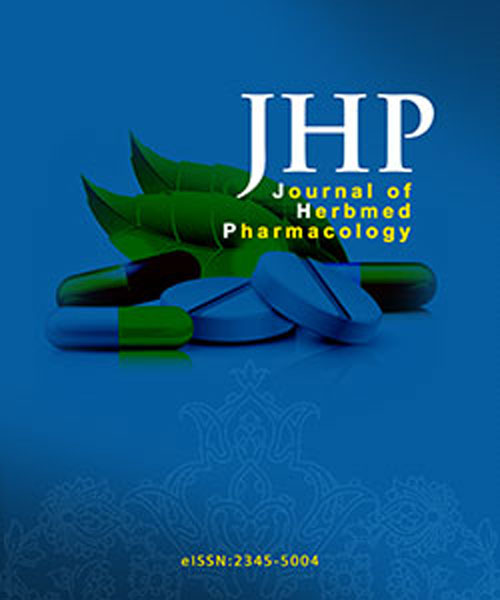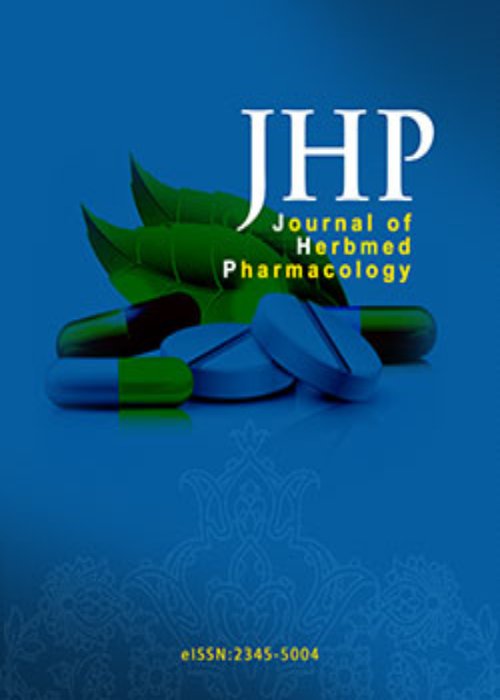فهرست مطالب

Journal of Herbmed Pharmacology
Volume:4 Issue: 3, Jun 2015
- تاریخ انتشار: 1394/04/10
- تعداد عناوین: 8
-
-
Pages 69-70Toxic metals are able to interact with DNA and nuclear proteins causing oxidative damage of biological macromolecules. Antioxidants can be used in metals induced toxicity. However, consumption of fruits and herbal extract is preferred compared to single supplements such as vitamins C or E.Keywords: Antioxidants, Metal toxicity, Oxidative stress, ROS
-
Pages 71-74IntroductionThe study aimed to investigate the antiviral activity of Zataria multiflora (ZM) essential oil against Newcastle disease virus (NDV) on Vero cells.MethodsThe cytotoxicity of ZM essential oil was evaluated by MTT assay. Cells were infected with 100 TCID50 of a field isolate of virulent NDV (JF820294.1). ZM essential oil at concentrations of 1/5000, 1/25 000, 1/125 000 or 1/625 000 was added at different times of infection: 60 minutes pre infection, simultaneously and 60 minutes post infection. Cells were evaluated morphologically. The TCID50, neutralizing index (NI) and HA titer were determined.ResultsCells treated with ZM essential oil in all concentrations 1 hour before or after infection, showed CPE similar to control virus cells. In simultaneous use, cells treated with 1/5000 concentration of the essential oil, remained morphologically normal. TCID50 values of all treatments were very close to that of control virus except for simultaneous administration at concentration of 1/5000 which was about 1000 folds lower. Virus titer in different treatments was exactly the same as control virus titer in Haemagglutination (HA) test.ConclusionZM essential oil has some antiviral activity on NDV in vitro, which is possibly by destruction of virus infectivity or inhibition of early phases of viral proliferation cycle.Keywords: Newcastle disease virus, Zataria multiflora, Vero cells, Anti viral activity
-
Pages 75-80IntroductionExposure to electromagnetic fields (EMFs) induces harmful effects on testis and reproductive activities. In traditional medicine, date palm pollen (DPP) which has remarkable nutritional values is used for curing male infertility and impotency. The aim of this study was to investigate the protective effect of DPP in preventing the detrimental effects of low frequency electromagnetic field (50 Hz) on sperm parameters and sexual hormones.MethodsAdult male mice were randomly divided into 7 groups of 8 and exposed to EMF 4 h/day for 10 days. In this study experimental groups received DPP with doses of 25, 50, 100 and 200 mg/kg, respectively before exposure. At the end of the experiment each group were tested for sperm parameters including: motility, count, morphology, viability and the level of luteinizing hormone (LH) and testosterone.ResultsOur results revealed that exposure to EMF induced significant reduction (P <. 001) in sperm count, viability and progressive motility in comparison with control group. EMF caused abnormalities in sperm and significant decrease in testosterone level while there was no significant difference in level. Administration of DPP before exposure improved the sperm count, viability, motility and testosterone level in experimental groups. In addition, pretreatment with DPP prevented the sperm abnormality induced by EMF.ConclusionThe results indicate the protective effect of DPP against EMF adverse effects on sperm parameters and sexual hormones in male mice.Keywords: Electromagnetic field, Testes, Sperm parameters, Sexual hormones, Infertility, Date palm pollen
-
Pages 81-84IntroductionBy considering an increase in drug resistance against red mites, finding the nonchemical herbal acaricide against Dermanyssus gallinae (De Geer) (Acari: Mesostigmata) is necessary to kill them and to reduce the chemical resistance against chemical acaricides in this specie. Dermanyssus gallinae is a potential vector of the causal agent of several viral diseases such as Equine encephalitis and St. Louis encephalitis. It can be a vector of bacteria such as Salmonella spp., Mycobacterium spp. and Erysipelothrix rhusiopathiae. It is also known to cause itching dermatosis in humans. In this study acaricidal and repellent activities of essential oil of Eucalyptus globulus against Dermanyssus gallinae were studied.MethodsAfter extracting the essential oil, different concentrations of the plant extract were prepared. Then, acaricidal effect of different concentrations was tested on poultry red mite, Dermanyssus gallinae, by dropping 3-4 drops of essential oil on mites. Repellent activity of essential oil was tested by Y-tube olfactometer bioassay. After the test, total number of killed and repellent mites reported.ResultsConcentration of 1:2 or 50% had more acaricidal effect on mites. Also essential oil of Eucalyptus globulus had repellent activity against red mites.ConclusionThis study showed that essential oil of Eucalyptus globulus had acaricidal and repellent activities against red mites. Hence it might be used as a herbal acaricide against it to kill and to reduce the chemical resistance in this specie.Keywords: Acaricidal activity, Dermanysuss gallinae, Essential oil, Eucalyptus globulus, Repellent activity
-
Pages 85-88IntroductionAloe vera is a medicinal plant with antioxidant activity. The purpose of this study was to determine the effect of Aloe vera on some indicators of cell damage after a period of aerobic exercise in male athletes of 15-18 years old.MethodsIn this clinical trial study, 20 male students with average weight of 64.85 ± 51 and height of 172.05 ± 6.4 were randomly assigned to 2 groups of Aloe vera supplement (n = 10) and placebo (n = 10). Then aerobic training was conducted for 4 weeks. The supplemented group took 3 capsules, each capsule contains 2 g of dried Aloe vera and placebo group took 3 capsules/day containing dextran after every meal. To determine the index of cell injury markers creatine kinase (CK), lactate dehydrogenase (LDH) and reactive protein C (CRP) were determined and blood samples were collected 24 hours before and after each test. The data were analyzed using ANOVA and independent t test. Significance level was considered as P ≤. 05.ResultsThe use of Aloe vera during aerobic exercise significantly reduced LDH (P =. 006) in the supplement group (15% reduction) compared to placebo group and CRP with 11% reduction in the supplement group compared to placebo (P =. 008). There was no significant reduction in CK.ConclusionThe findings of this study showed that Aloe vera reduces cell damage and inflammation indicators. This result may reflect the role of Aloe vera as anti-inflammatory and antioxidant agent.Keywords: Aloe vera, Index of cellular damage, Antioxidant, Boys, Athletic
-
Pages 89-92IntroductionMucormycosis is an opportunistic fungal infection. Rhizopus oryzae is major cause of mucormycosis in humans. This disease is the most common form of the acute fungal infection with rapid progress. Iranian Propolis extract and Royal jelly are honey bee products which have been used by human over the past centuries in traditional medicine. In this study the effects of Iranian Propolis and Royal jelly were investigated against Rhizopus oryzae and Candida albicans.MethodsThe used method in this study was microdilution. To perform it, the prepared dilutions of Royal jelly and alcoholic extract of Iranian Propolis were added to tubes containing Sabouraud dextrose broth culture media except to control group and then Rhizopus oryzae suspension was added to all microtubes. In the next stage, microtubes were maintained in incubator at 25oC for 48 hours and then 10 ml of the content of each microtube was transferred to Sabouraud dextrose agar media. The minimum inhibitory concentration (MIC) and minimum fungicidal concentration (MFC) of the agents were calculated.ResultsIn this study, the MIC and MFC of Iranian Propolis alcoholic extract on Rhizopus oryzae were respectively 0.1 and 0.25 mg/ml and the MFC of Royal jelly on Rhizopus oryzae were respectively 100 ± 34 and 133 ± 46 mg/ml.ConclusionThe results indicate that Propolis might be used as an ideal combination for the treatment of fungal infections like Rhizopus oryzae. However, clinical studies are needed to confirm the effects of these drugs.Keywords: Propolis, Royal jelly, Candida albicans
-
Pages 93-97IntroductionOptimizing an ideal culture system that is comparable to follicle environment to obtain mature oocytes is one of the important criteria in in vitro maturation (IVM). Phoenix dactylifera L. commonly known as date palm is an important herb in Asia folk medicine that is used to improve fertility in women from ancient time. The aim of this study was to investigate the effect of date palm pollen grain extract on IVM of mouse follicles.MethodsIn this study follicles with 1 or 2 layers of granulosa cells and round oocytes were isolated from 2-3 weeks old female NMRI mice ovaries. Follicles were cultured in IVM media with different concentrations 0, 10, 20, 30, 40 μg/ml of palm pollen grain extract for 12 days. Then, the effect of date palm pollen grain on follicular growth and maturation were analyzed.ResultsThere was a significant increase in follicle growth and maturation rate in all treated groups as compared to the control group, but maturation rate was significantly higher in the presence of 20 μg/ml palm pollen grain.ConclusionSupplementation of IVM media with date palm pollen grain extract improves the IVM of follicles.Keywords: Follicle, Oocyte, In vitro maturation (IVM), Date palm pollen grain
-
Pages 98-101IntroductionChamomile tea (CT) is an herbal tea and is served as a beneficial herbal infusion all over the world. Its major polyphenols constituents and tea-catechins have been shown to have health benefits. Operating room staff are commonly exposed to damaging factors, such as radiation, waste anesthetic gases and psychological stress. One of the most important qualities of CT is its antioxidant property. The aim of this study was to evaluate the effects of CT in reducing the oxidative stress of operative room staff that are chronically exposed to damaging factors.MethodsIn this study we approached to 20 operating room personnel. The subjects drank 2 cups of CT (every cup contained 1.8730 g of chamomile and 300 ml of water) daily, one cup in the morning and another in the afternoon for 21 days. A questionnaire that contained personal information was filled by each subject. Oxidative stress parameters such as total antioxidant capacity (TAC), catalase (CAT) and total thiol molecules (TTG) were measured 2 times: first before drinking CT at the first day and the next time after the 21st day.ResultsConsumption of CT by subjects caused a significant induction in TAC (6.62 ± 0.77 vs 4.81± 0.39 ųmol/ml, P <. 05) of saliva. There was not any statistically significant change in saliva TTG and CAT after 21 days of drinking CT.ConclusionIn the end we came to conclusion that CT can be a useful additional food to remove the oxidative damage that happens to operating room staff.Keywords: Chamomile tea, Operating room staff, Oxidative stress, Anesthetic gases


